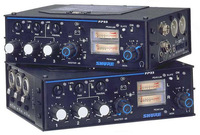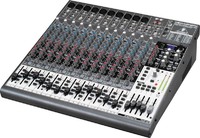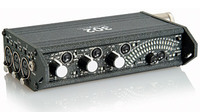![]() Depending on the type of production that one does, there are two basic reasons to use a mixing panel: remote control or complete control.
Depending on the type of production that one does, there are two basic reasons to use a mixing panel: remote control or complete control.
 In the case of ENG production, cinema verite, or “run & gun” documentary – the mix panel serves as a remote input system for audio recording (such as the Shure FP33 at left). By this, I mean that the mixing panel is an extension of the camcorder, allowing the soundperson to access the mic input controls (volume) of the camcorder without having to push aside the camera operator in order to set microphone input levels or to ride gain (volume) during a scene.
In the case of ENG production, cinema verite, or “run & gun” documentary – the mix panel serves as a remote input system for audio recording (such as the Shure FP33 at left). By this, I mean that the mixing panel is an extension of the camcorder, allowing the soundperson to access the mic input controls (volume) of the camcorder without having to push aside the camera operator in order to set microphone input levels or to ride gain (volume) during a scene.
In addition to giving the soundperson control of the mic levels -- the over-the-shoulder ENG mixing panel allows the deployment of multiple mics (usually up to three or four), along with Phantom powering, and headphone monitoring.
The ENG mixers may also offer amenities such as a slating mic, line-up tone, low-cut filters, limiter, and pan pots. Powering of the mix panel is from internal batteries, such as 9v alkalines or rechargeables.
Specific features will vary, of course, from model to model.
Popular, broadcast grade ENG mixing panels include the Shure FP33, Sign Video ENG44, Rolls MX442, and the highly acclaimed Sound Devices models 302 and 442.
 The other class of mixing panels is the location console, so to speak (such as the Behringer Xenyx 2442FX at right). These mixing boards are not over-the-shoulder portables, but are used off of a location soundcart or tabletop. Most of these boards require AC powering, although some of the higher end models can run off of internal or external 12v batteries.
The other class of mixing panels is the location console, so to speak (such as the Behringer Xenyx 2442FX at right). These mixing boards are not over-the-shoulder portables, but are used off of a location soundcart or tabletop. Most of these boards require AC powering, although some of the higher end models can run off of internal or external 12v batteries.
What makes this group of mixing panels different than their ENG brethren is that they offer complete and smooth control of the audio inputs and outputs. This advanced control of the signal is essential in professional theatrical film/video production.
The mixing panel has more elaborate input modules that offer balanced XLR inputs, mic powering, trim pots, low cut filters, equalization, solo PFL, pan pots, channel assigns, and smooth faders. Outputs include main outs to the recorder, headphones for the soundperson, outputs for Director/Script, and a way to send audio to the boom operator.
Whether you are using only one mic, or several, the mixing panel gives you maximum and consistent control over your signal. Considering that recording media are in a state of constant evolution, it is important to work from a board that will remain constant regardless of whether you are ultimately recording onto a vintage Nagra reel-to-reel, a digital audio recorder, camcorder or whatever the next NAB Show may bring.
Common features of an ENG Mix Panel
 The majority of ENG mixers are simple and straight forward in their operation, such as the Sound Devices Model 302 (shown).
The majority of ENG mixers are simple and straight forward in their operation, such as the Sound Devices Model 302 (shown).
The most important thing is to make sure that your batteries are fresh. Most mixers can only run one or two days at most on a set of batteries.
The inputs are generally on the side of the unit. There may be a switch for selection of mic or line level input.
Phantom powering is often selected by a dip switch or toggle, located either in the battery compartment or along the outer spine.
 Each mic input has a main volume control (gain pot), along with a pan pot to assign the sound to left/right or somewhere in between. If the tracks are going to be painstakingly edited, it is better to assign the mics to only left or right tracks, and let the editor do the “panning” during post-production. Some mixers also have a knob that functions as the trim pot, which allows you to adjust the overall sensitivity for each individual volume control. This lets you rough out the levels so that, as you mix live audio, the main pots play mostly in the center (giving you ample “arc” to raise or lower the voice; otherwise, you might be playing some voices at one extreme end or the other of the knob’s rotation).
Each mic input has a main volume control (gain pot), along with a pan pot to assign the sound to left/right or somewhere in between. If the tracks are going to be painstakingly edited, it is better to assign the mics to only left or right tracks, and let the editor do the “panning” during post-production. Some mixers also have a knob that functions as the trim pot, which allows you to adjust the overall sensitivity for each individual volume control. This lets you rough out the levels so that, as you mix live audio, the main pots play mostly in the center (giving you ample “arc” to raise or lower the voice; otherwise, you might be playing some voices at one extreme end or the other of the knob’s rotation).
The gain pots of a mixer offer smoother control over the dialog than if you plugged directly into the camera. On the camcorder, even a small adjustment of the input knob will result in a coarse and drastic rise or drop in level. Riding gain during a dramatic passage is virtually impossible. Mixing boards, on the other hand, provide mic pots that are ramped or sloped so as to permit much more subtle level changes.
A master gain control will raise or lower the overall level of your incoming signals. On some mixers, such as the Shure FP33, the master gain also sets the reference tone level. You do not need to leave the master set at the same level that you used for zero-ing the tone. Once the tone has been recorded, feel free to make use of the master to keep your levels optimum without having to turn your mic inputs to extreme.
Now we'll discuss low cut filters...
